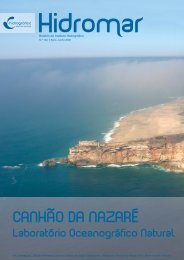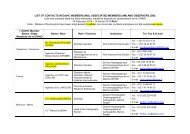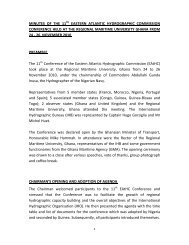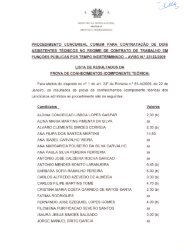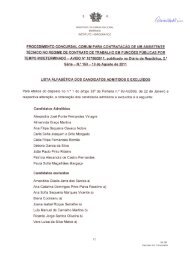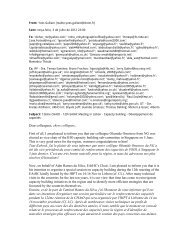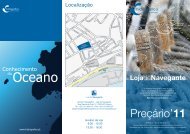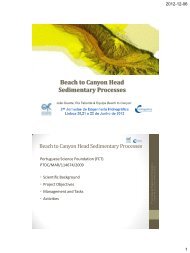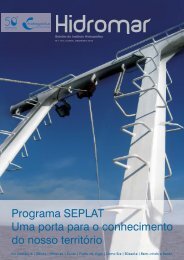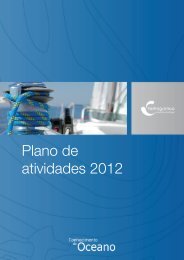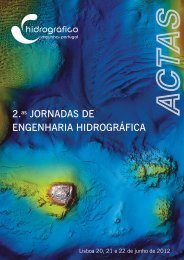Create successful ePaper yourself
Turn your PDF publications into a flip-book with our unique Google optimized e-Paper software.
PRE-PROCESSING AND POST-PROCESSING OF MODEL WAVE DATA IN THE NEARSHORE 73<br />
0.4 , j 3 # 0.4 – spilling;<br />
0.4 , j 3 # 2.4 – plunging;<br />
2.4 , j 3 # 2.6 – plunging / collap sin g; (6)<br />
2.6 , j 3 # 3.1 – collap sin g / surging;<br />
2.4 , j 3 . 3.1 – surging.<br />
There were used also in this module some results from<br />
the linear theory for estimating the breaking ratio and<br />
the number of wave fronts in the surf [Soares et al 2000].<br />
4.5 Options for cumulative and parallel<br />
data analysis<br />
Besides the capacity of this new designed nowcasting<br />
tool to process and present graphically (and numerically),<br />
data concerning a specific moment of the sea<br />
state in the considered area, it was created also the<br />
possibility for the user to make a time evolution analyze<br />
of the wave parameters. Consequently although most of<br />
the variables are reinitialized any time when is changed<br />
the case, some other variables are loaded as global<br />
vectors, which perpetuates and extend their dimension<br />
in each case analyzed. In this way ‘TOTAL WAVE’ can be<br />
used not only for studying the distribution in space at<br />
one instant of the wave variables, but also to visualize<br />
their time evolution and to design automatically some<br />
forecast products. Another new option is the parallel<br />
analysis that can be <strong>do</strong>ne with different win<strong>do</strong>ws either<br />
in terms of spatial or temporal variations.<br />
5. Some concluding remarks<br />
High-resolution numerical wave models, being able<br />
to generate forecast products of the oceanographic data,<br />
are nowadays utilized more and more, to provide in a<br />
near real time scale the environmental support for<br />
significant areas. This concerns especially the coastal<br />
environment where the influence of the nonlinear<br />
effects is much higher than in the offshore areas.<br />
However, while the general research was focused in<br />
developing the physics of the spectral phase averaged<br />
models by improving the nonlinear source terms, there<br />
is still a strong need of easy to use interfaces for an<br />
adequate pre-processing and post-processing of the<br />
data. With this motivation the goal of the present work<br />
was to develop a new pre-processing tool for the coastal<br />
environment ‘BARCO’, with graphical and numerical<br />
outputs, which would be used in correlation with an<br />
advanced version of an already developed post-processing<br />
nowcast tool ‘TOTAL WAVE’. Because of its high<br />
performances in integration between computations and<br />
visualization effects was used the MATLAB environment.<br />
Moreover both the data import and the actions control<br />
were performed using the UI-commands. The data files<br />
were introduced into the system by commands of the<br />
type ‘UIGETFILE’ while the global variables by ‘EDIT<br />
BOXES’. In the same time the simulations were initiated<br />
usually by ‘UI-MENU’ commands and the actions<br />
inside a simulation are controlled by ‘PUSH BUTTONS’,<br />
following in this way the MATLAB internal hierarchy.<br />
The two programs were applied successfully<br />
together with the SWAN model, but they could be also<br />
useful in conjunction with most of the existent wave<br />
models. There were made available, in a user-friendly<br />
way, graphical and numerical outputs for the main wave<br />
parameters in the nearshore. Moreover using the results<br />
of the linear theory where evaluated the characteristics<br />
of the breaking process. There are some important<br />
benefits brought by the tools developed herewith. First<br />
in this way can be made a better selection of the area<br />
where is going to be run the model. Then is a drastically<br />
decreasing of the computational time of the model<br />
because of the reduced number of the output requests.<br />
Fig. 17 – Spctral analysis Fig. 18 – Surf-zone conditions



